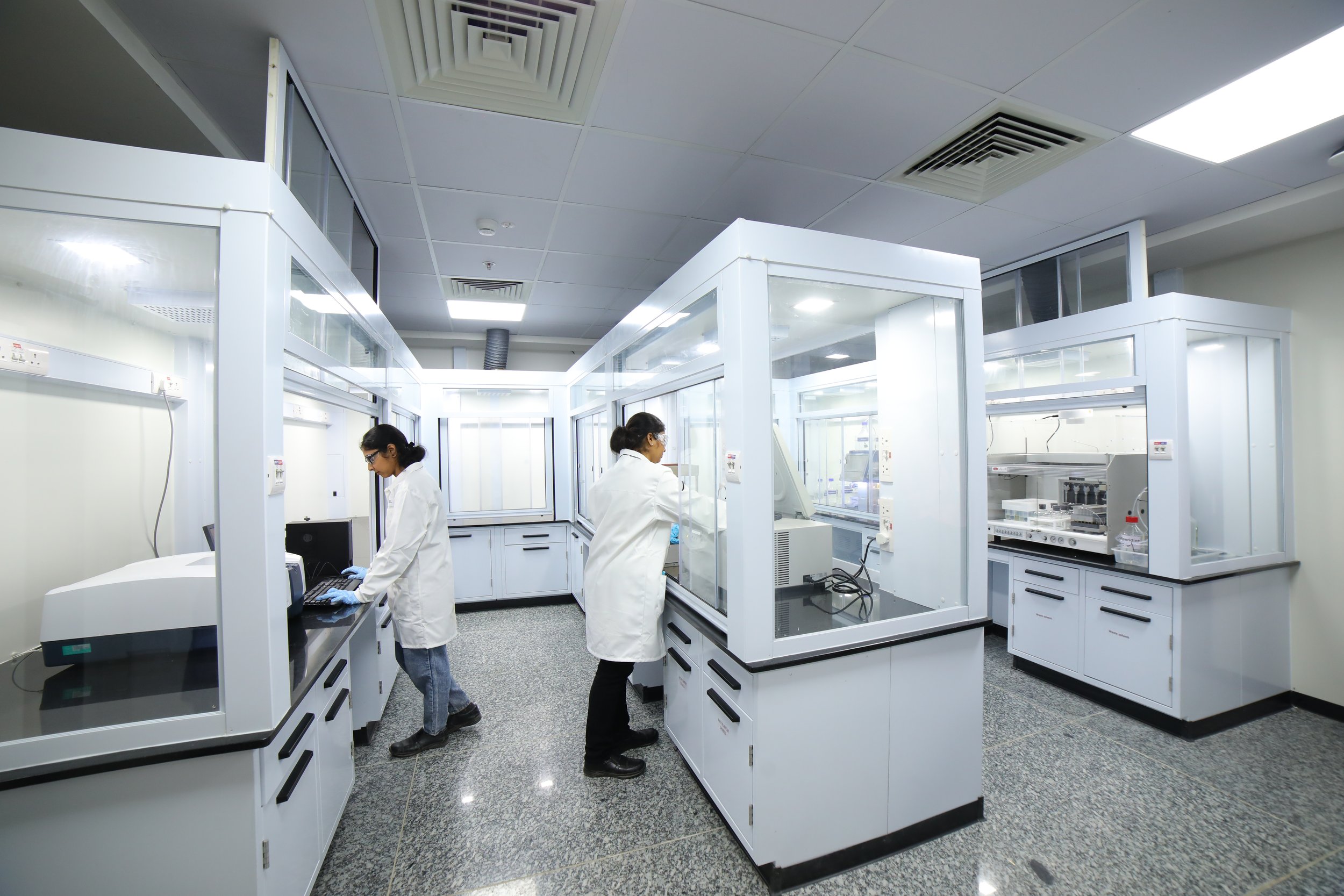The Structural Foundation of a Growing Peptide Research Hub
Sai Life Sciences' new Peptide Research Center in Hyderabad enhances drug development capabilities with advanced automation, robotics, and integrated peptide discovery services. Image: Courtesy of Sai Life Sciences, Peptide Research Center
Sai Life Sciences has unveiled a state-of-the-art Peptide Research Center at its integrated R&D campus in Hyderabad, India, marking a strategic expansion to meet growing demand for peptide-based therapeutics. Designed to support pharma and biotech innovators, the facility offers specialized services in peptide synthesis, discovery, and complex conjugation, powered by advanced automation, robotics, and high-throughput systems. With experienced scientific teams and integration into Sai’s broader discovery services—from chemistry to toxicology—the new center enhances precision, scalability, and efficiency across the drug development pipeline.
Lab Design News spoke with Dr. Santosh Kulkarni, vice president, medicinal chemistry with Sai Life Sciences, regarding the design, construction, and strategic vision behind the cutting-edge facility.
Q: What were the core design priorities for the Peptide Research Center, and how were they tailored to support high-throughput peptide synthesis and complex conjugation workflows?
A: The design of the Peptide Research Center was rooted in a fundamental understanding of scientific workflows. Our goal was to create a purpose-built environment that would support the entire spectrum of peptide-related activities—from reagent and peptide storage to high-throughput synthesis, purification, and complex conjugations, including those involving high-potency compounds. A key differentiator was the decision to co-locate all these functions within a single integrated space. This proximity not only enhances operational efficiency but also reduces transfer times, minimizes risk, and fosters real-time collaboration. The lab’s spatial organization ensures that scientists can move fluidly between synthesis, analytical instrumentation, and conjugation zones—enabling a more agile and cohesive approach to complex peptide workflows.
Designed with automation at its core, the lab features customized layouts and workbenches tailored to current and future robotic systems, ensuring long-term scalability and technical precision. Image: Courtesy of Sai Life Sciences, Peptide Research Center
Q: How did the integration of automation, advanced liquid handling, and robotics influence the spatial planning and infrastructure requirements of the facility?
A: Automation was a foundational consideration in the facility’s planning phase. We engaged early with equipment suppliers and engineering teams to understand the unique spatial and utility demands of automated liquid handling systems and other robotic platforms. This led to customized workbench designs and a floor plan that could not only accommodate current-generation instruments but also allow for future scalability.
Rather than following a generic lab layout, the design was bespoke—shaped entirely by the specific needs of our workflows, equipment specifications, and long-term automation roadmap. The result is a lab that is both technically robust and operationally future-ready.
Q: What challenges did you encounter during the construction or retrofitting process at the Hyderabad R&D Campus, especially when building a facility specialized for emerging therapeutic modalities like peptides?
A: One of the key challenges was adapting to the evolving scale and ambition of our peptide program. The initial lab was designed with a relatively modest footprint. However, as our internal roadmap grew and market demand for peptide therapeutics accelerated, it became clear that the original design would be insufficient.
The Peptide Research Center is seamlessly integrated into Sai Life Sciences’ broader discovery ecosystem, enabling cross-disciplinary collaboration and streamlined workflows across small molecules, biologics, and peptides. Image: Courtesy of Sai Life Sciences, Peptide Research Center
We responded by expanding the designated space mid-cycle and revisiting several layout decisions to better reflect our broader vision. In that sense, the design process was highly iterative—requiring flexibility in both planning and execution. The final facility is a direct outcome of this dynamic evolution, shaped by both strategic foresight and real-time responsiveness.
Q: Can you elaborate on how the Peptide Research Center is designed to facilitate seamless integration with Sai Life Sciences’ broader discovery services, from medicinal chemistry to toxicology?
A: Integration is a core tenet of Sai Life Sciences’ discovery offering. Today, approximately 65 to 70 percent of our programs operate on an integrated platform, spanning medicinal chemistry, biology, DMPK, and toxicology. The Peptide Research Center was designed to align seamlessly with this model.
It is not a stand-alone unit but a functional extension of our broader discovery ecosystem. Scientists across modalities—including small molecules and biologics—can collaborate fluidly, leveraging shared platforms and co-located infrastructure. This enables us to bring the same level of integration and efficiency to peptide-based discovery programs as we do to traditional drug discovery engagements.
Balancing safety, scalability, and sustainability, the lab features advanced air handling, modular design for future growth, and energy-efficient systems aligned with Sai Life Sciences’ green building goals. Image: Courtesy of Sai Life Sciences, Peptide Research Center
Q: How does the new center reflect Sai Life Sciences’ commitment to sustainability, safety, and scalability in laboratory design?
A: The lab design reflects a balanced focus on safety, scalability, and sustainability. From a safety standpoint, the facility features advanced air handling systems, ergonomic workstations, and comprehensive fire protection infrastructure. The modular layout supports phased expansions, ensuring that the space can grow alongside the business.
On the sustainability front, the lab adheres to industrial design principles that reduce reliance on non-recyclable materials and optimize energy efficiency. While we continue to refine our sustainability metrics in collaboration with our engineering and EHS teams, the lab aligns with our corporate commitment to minimizing environmental impact—part of a broader strategy that includes responsible infrastructure planning and a shift towards green building practices.




